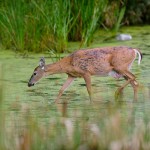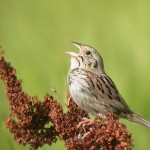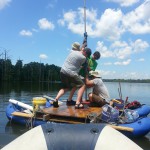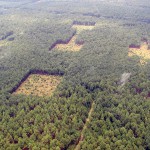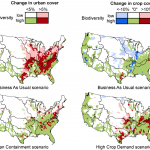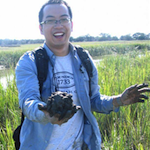Tag Ecology
Ecologist/hunter talks deer, plants, hunters and balance
UW-Madison Professor of Botany Donald Waller is a pioneer in exploring the impact of deer in natural habitats. For more than 20 years, Waller - who counts himself among the state's deer hunters - has led research on the economic, health and environmental impacts of deer, including:
Balancing birds and biofuels: Grasslands support more species than cornfields
In Wisconsin, bioenergy is for the birds. Really. In a study published today in the journal PLOS ONE, University of Wisconsin–Madison and Wisconsin Department of Natural Resources (DNR) scientists examined whether corn and perennial grassland fields in southern Wisconsin could provide both biomass for bioenergy production and bountiful bird habitat. The research team found that where there are grasslands, there are birds. Grass-and-wildflower-dominated fields supported more than three times as many bird species as cornfields, including 10 imperiled species found only in the grasslands.
Madison Reads Leopold set for Saturday at UW Arboretum
The UW Arboretum's ninth annual Madison Reads Leopold event anchors the celebration of Aldo Leopold Weekend in the Madison area with a mix of citizen and celebrity readers giving voice to Leopold's "A Sand County Almanac."
Seed dispersal gets a test in carved-out ‘habitat corridors’
Field ecologists go to great lengths to get data: radio collars and automatic video cameras are only two of their creative techniques for documenting the natural world. So when a group of ecologists set out to see how wind moves seeds through isolated patches of habitat carved into a longleaf pine plantation in South Carolina, they twisted colored yarn to create mock seeds that would drift with the wind much like native seeds.
Study puts freshwater biodiversity on the map
When it comes to economic growth and environmental impacts, it can seem like Newton's third law of motion is the rule - for every action, there is an equal and opposite reaction - and that in most cases, the economy prospers and the environment suffers.
Scientists find early warning indicators of major ecological change
Day after day, the buoy bobbed at the surface of Peter Lake. Every five minutes, or 288 times a day, instruments in the water silently recorded samples without creating so much as a ripple. But, beneath the surface, the lake - just across Wisconsin's northern boundary in Michigan's Upper Peninsula - was in turmoil. The buoy was busy documenting massive change.
Ecologists map the benefits of our ecosystems
Two ecologists at the University of Wisconsin–Madison report this week (July 1) in the Proceedings of the National Academy of Sciences a novel approach to analyzing the production and location of 10 different ecosystem services across a landscape, opening the door to being able to identify factors governing their synergies and tradeoffs.
In the eastern U.S., spring flowers keep pace with warming climate
Using the meticulous phenological records of two iconic American naturalists, Henry David Thoreau and Aldo Leopold, scientists have demonstrated that native plants in the eastern United States are flowering as much as a month earlier in response to a warming climate.
Aldo Leopold’s field notes score a lost “soundscape”
Among his many qualities, the pioneering wildlife ecologist Aldo Leopold was a meticulous taker of field notes.
Mathematical ecologist wins prestigious award
University of Wisconsin–Madison ecologist Anthony Ives is being recognized with the prestigious Robert H. MacArthur Award from the Ecological Society of America (ESA).
Forest ecologist receives distinguished award
David Mladenoff, the Beers-Bascom Professor in Conservation in the Department of Forest and Wildlife Ecology, has received the 2012 Distinguished Landscape Ecologist Award.
Report assesses climate change impacts, adaptation strategies
A statewide collaborative of scientists and diverse stakeholders is proposing a multitude of measures to help protect and enhance Wisconsin's natural resources, economic vitality, and public well-being as the state's climate becomes warmer and wetter.
Water, water everywhere focus of new sustainability project
An interdisciplinary team of scientists and engineers at the University of Wisconsin–Madison is turning a comprehensive lens on Madison's water in all its forms - in the lakes, streets, faucets, ground and atmosphere - thanks to the National Science Foundation.
Plant family tree may help identify species vulnerable to invaders, climate change
Change has been the norm for Wisconsin's forests over the last 50 years, and the next 50 are unlikely to pass quietly.
Bioenergy choices could dramatically change Midwest bird diversity
Ambitious plans to expand acreage of bioenergy crops could have a major impact on birds in the Upper Midwest, according to a study published today (Oct. 4) in the online edition of the Proceedings of the National Academy of Sciences (PNAS).
New book explores widespread, troubling legacy of synthetic chemicals
Environmental historian Nancy Langston started her latest book planning to highlight the lasting legacy of manufactured chemicals that touched the lives of millions of Americans in the 1950s and 1960s.
Migratory birds bear brunt of climate-charged weather
As global climate change fuels more frequent and intense hurricanes and droughts, migratory birds, especially those whose populations are already in decline, will bear the brunt of such climate-fueled weather, suggest a pair of new studies.
Conservation areas threatened nationally by housing development
Conservationists have long known that lines on a map are not sufficient to protect nature because what happens outside those boundaries can affect what happens within. Now, a study by two University of Wisconsin–Madison scientists in the department of forest and wildlife ecology measures the threat of housing development around protected areas in the United States.
Surveying bird biodiversity from space?
A fundamental rule of wildlife ecology says that diverse habitats foster greater biodiversity: The Amazon has far more species than Greenland. But how do habitat and biodiversity relate in a state like Wisconsin, with its range of farms, forests, wetlands, cities, suburbs and highways?

